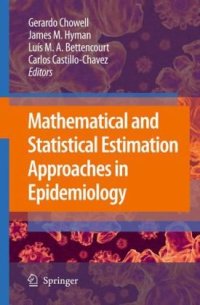
Ebook: Mathematical and Statistical Estimation Approaches in Epidemiology
- Genre: Mathematics // Applied Mathematicsematics
- Tags: Statistics for Life Sciences Medicine Health Sciences, Biomedicine general, Epidemiology, Infectious Diseases
- Year: 2009
- Publisher: Springer Netherlands
- Edition: 1
- Language: English
- pdf
Mathematical and Statistical Estimation Approaches in Epidemiology compiles t- oretical and practical contributions of experts in the analysis of infectious disease epidemics in a single volume. Recent collections have focused in the analyses and simulation of deterministic and stochastic models whose aim is to identify and rank epidemiological and social mechanisms responsible for disease transmission. The contributions in this volume focus on the connections between models and disease data with emphasis on the application of mathematical and statistical approaches that quantify model and data uncertainty. The book is aimed at public health experts, applied mathematicians and sci- tists in the life and social sciences, particularly graduate or advanced undergraduate students, who are interested not only in building and connecting models to data but also in applying and developing methods that quantify uncertainty in the context of infectious diseases. Chowell and Brauer open this volume with an overview of the classical disease transmission models of Kermack-McKendrick including extensions that account for increased levels of epidemiological heterogeneity. Their theoretical tour is followed by the introduction of a simple methodology for the estimation of, the basic reproduction number,R . The use of this methodology 0 is illustrated, using regional data for 1918–1919 and 1968 in uenza pandemics.
This book is intended as a primary resource for graduate students and researchers working in the field of infectious disease epidemiology. This collection of contributions presents deterministic and stochastic approaches for epidemic modelling and statistical inference of epidemiological parameters including the real time assessment of the transmission potential of infectious diseases, issues related to the sensitivity of model assumptions, the use of historical archives as valuable sources of epidemiological information, modeling of vaccination programs and relapse, statistical challenges in bio surveillance, approaches for the spatial and temporal analysis of disease time series, quantification of parameter uncertainty and methodologies for sensitivity analysis. Methods and tools are illustrated with simulated and real datasets such as the 1918 influenza pandemic in Winnipeg, Canada, the 1968 influenza pandemic in US cities, Severe Acute Respiratory Syndrome (SARS), the 2005 Marburg fever outbreak in Angola, rubella epidemics in Peru, rotavirus in Mexico and pneumococcal disease in Australia.